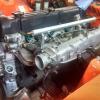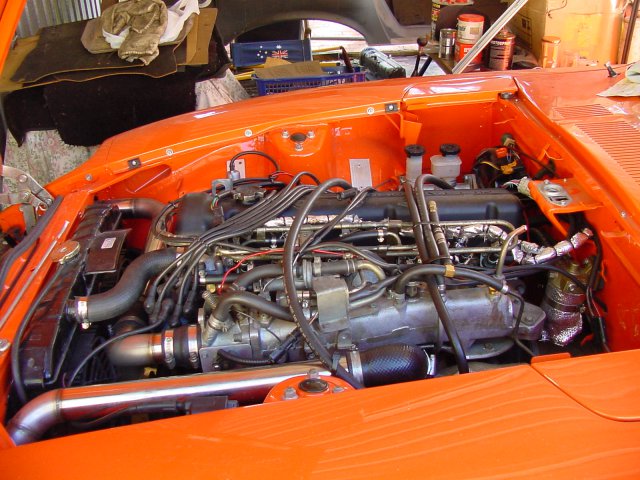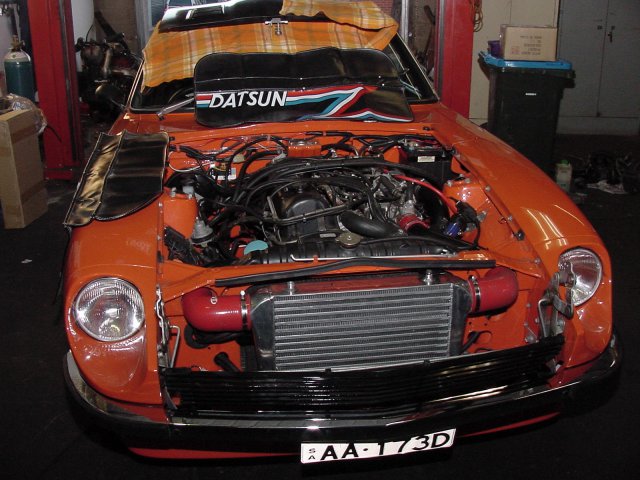-
Posts
120 -
Joined
-
Last visited
Content Type
Profiles
Forums
Blogs
Events
Gallery
Downloads
Store
Everything posted by Ben
-
I've spent a bit of time in the last couple of weeks working on the CV fitting issue on my '73 240Z and have found some anomalies with the specifications of the CV shafts as discussed here. My 'original' pair of Z31T shafts are as described - LHS= short inner/short shaft, RHS= long inner/long shaft. I've flipped the cages (FWIW) and there was no way I could get the RH shaft to fit at full droop without significant strain on the suspension. Which, as has been discussed at length, is unacceptable. (I've got Poly bushes, but otherwise stock LCA's) Therefore I decided to see if I could get another 'short' shaft and build a hybrid RH assembly (also discussed here). So last week, I managed to get an HR31 shaft. It's a RH shaft (long inner), but has the shorter shaft fitted (~150mm exposed shaft between the boots vs ~170mm for the long one). So at that stage I'm a bit perplexed. Today I picked up a pair of shafts from a 300ZR-II and they are consistent with the HR31 shaft - long inner/short shaft & short inner/long shaft. I've also been watching a set of HR31 shafts in Japan; Which look the same as the ones I've just bought - short inner/long shaft & long inner/short shaft. Can anyone shed some light on this? It's completely opposite to what has been talked about here. I'll be using the 'standard' HR31 shaft at this stage (my original 'long' Z31T shaft actually has a crack in the outer CV housing, and the 300ZR shafts need a full recondition). I'm not sure if any other modifications will be required on the RHS to get a good fit, but it will be a while before I can check it out as my LCA is getting re-powdercoated and new Poly bushes are required due to a long-term brake fluid leak
-

Brake Upgrade Questions
Ben replied to daddydonuts's topic in Brakes, Wheels, Suspension and Chassis
For clarifications sake; The R31 calipers I'm using are the Australian PBR version, not the JDM version. The rear rotor I'm using is 258mm, the JDM HR31 would be a 290mm rear rotor. 15/16 '280ZX' MC's aren't available over the counter here anymore , Nissan don't stock them and the aftermarket have ceased production, so that removed my first preference. My point is that unless you have access to a brake testing rig to check, the bias could be all over the shop - it's not only the piston area that matters, the pad area and heat-shedding capabilities of the system are relevant too. An aftermarket PV gives you the flexibility to get it right, rather than being stuck with the original proportioning % numbers. That is, unless you are doing a full brake swap on a like-for-like vehicle (e.g. fitting R32 GTR brakes to an R32 GTS-t, including the M/C). -

Brake Upgrade Questions
Ben replied to daddydonuts's topic in Brakes, Wheels, Suspension and Chassis
My recommendation - option 2; Lose the stock PV, and fit an adjustable inline one to the rear circuit. I've done just that (the setup was stock M/C, Hilux front, R31 rear), the bias was dialled in when the car was checked for compliance after the turbo engine installation. The front M/C circuit goes directly to a distribution block, and the rear circuit is directly connected to the Willwood PV. The OEM brake warning 'device' was that gummed up, that it would have never shown a failure anyway... You could always fit float alarms to the M/C reservoirs if you wanted to retain a warning system. The authorities were happy with the brake bias, but I wasn't so keen on the pedal travel. The car now sports a Z31/4Runner front and 1" M/C. I haven't driven it since the front upgrade, but the pedal was certainly firm with the 1" M/C! -
My original setup had 2" SS piping and an AiResearch intercooler: The current setup uses 2.5" MS piping, and 450x300x76 FMIC: I too swapped the hot/cold side plumbing in my second version. The intercooler/plumbing changes saw an extra 3psi boost at the same WG duty-cycle, and allowed a 15kW increase via lower AIT's and the ability to lean out the mixture.
-
You'll also need the G-Sensor from underneath the centre console if you want the AWD to do it's thing.
-
Have you re-torqued it yet? If not, what's the hold up? And the next time you assemble the block/head, use a bit of Hylomar adhesive spray - it's good stuff...
-
For those who haven't seen it, here's another combo (Carb/EFI) turbo setup from the JDM madness heyday... Jeez, I love modern EFI - there's no way I could be bothered dealing with all this stuff. It's potentially so fiddly that you'd never get to drive the car! Just go EFI, it's the sane thing to do!
-
I shall do just that. Like I have said in other threads; I'm interested in using Water Injection with my application, but haven't done so as yet and defer to those in the know!
-
E10 could cause in increase in pre-ignition, if the EMS is not able to cater for the increased fuelling requirements, and you were already running a little lean on Gasoline etc. As for destructive detonation - I highly doubt that E10 would cause a perfect motor to grenade without some other significant contributing factors. You can potentially squeeze a few more HP out of an 'E' blend, as it tends to be rated at a higher octane. There are a few brands of 98RON PULP available here in South Australia that have an Ethanol content (but not as high as 10%), and I'm fairly confident that I get nicer running from my RB25DET with this fuel than plain-Jane 98RON (rated) Gasoline. The economy suffers a little, but she's a happier engine on the whole. Pure methanol is a different story (~6:1 AFR's, corrosive, and more power - potentially), and I'd only ever run water injection - but that's a climate issue. It never gets cold enough here to warrant the anti-freeze attributes that the tiny % of Methanol brings to the water/meth blend. And that's what the Meth is there for; not more power, but anti-freeze. Solving the detonation problem is best attacked form many angles - charge cooling, sane boost, good mixtures, sensible timing, spot-boiling control (which thanks to this thread I have learnt a lot more about), and anti-detonants (choose your poison!).
-
Apologies for the digression.
-
If you need to get either VL or R31 RB30 blocks, being in OZ I might be able to secure stock for you. PM me if you want to discuss further.
-
Damn... Methinks that this is a perfect example of going 'a little too far'
-
You guys with Direct-fire systems could pretty much run whatever timing you like (physically speaking). Bus those of us running a locked distributor can only adjust our maps until we run out of wipe on the rotor button. This is still plenty, but it could be a stretch trying to get 45+ deg total advance with this kind of setup. It also depends on how much you can actually dial into your EMS, but you can always adjust the trigger angle to get a little more
-
No specific anti-detonants or supplementary fuels here, but then again I'm not running 'big' numbers. I am partial to water injection, and will probably fit an Aquamist system to the car in the future.
-

Will A Gear reduction starter help my Carbed Z start faster?
Ben replied to at-jefft's topic in S30 Series - 240z, 260z, 280z
If you're still running the Kettering ignition, check your points - if they've closed up your spark will be piss-poor and starting a cold engine needs a good spark. -
May I suggest that ideally 'audible' would be using a knock-box and headphones? I know that my tuner could detect the first hints of rattle by my RB25DET way before it became audible to me (and therefore adjust the tune before an observer even knew what was happening). I'm also noticing that a couple of these posted maps seem to have the timing taper off at around 5000rpm. I would think that the point for the least amount of timing would be at peak cylinder pressure - approx. peak tq. My maps (and others in this thread) have reduced timing at around 4500rpm and then we wind it back in as the rpm's increase towards redline.
-
I don't think it would. But I defer to the professionals in the field, as I too may be missing something!
-
Without oil (or specified lube), the fastener will bind in the threads (and may not torque down properly), probably rust, and then snap off when you try to remove it. I really hate pulling an engine apart that has dry, creaky head bolts... (And where are those maps? It's 0530 Thursday! Get out of bed and upload them! )
-
Thermostats aside, a cooling system that has not reached capacity can only cool to a certain temperature differential (excuse my lack of correct terminology, it's been a long time since I did any physics...). As the ambient temperature rises, the capability to maintain the desired coolant temperature decreases. Hence why cars are more prone to overheat on hot days - a substandard cooling system reaches capacity due to the ambient temperature and cannot shed the heat faster than it's being produced. Where I'm going with this is that in the climate my car operates in, the ambient temperature can rise to well over 40C - we had a 45C last summer - and my work car was operating within-spec at 113C coolant temperature (I tried to boil it, really I did!). In these conditions, the engine coolant certainly gets hot enough to cause a 13psi cap to vent and then recover (I have a recovery cap/tank on my 240Z). When running my Z-car on the dyno at ~95C coolant temperature, the venting was sufficient to overflow the recovery tank, which then means that when the engine cools, there is a significant chance of having a low coolant level, which in turn leaves compressible gas in the system. That gives the system the perfect opportunity to allow steam pockets to form at the worst time, in the worst place... For me, a higher pressure cap has merit in containing the coolant on a hot day, and reducing the likelihood of hot-spots forming around the chambers when the going gets tough. Not that I'm a big fan of doing it, but my work car operates at around 100C on a 20C day - probably to allow for leaner mixtures and the more favourable economy that follows. I get real nervous of the spring-type hose clamps operating at that system temp/pressure. But it's all by-design, and thankfully it's not my problem if something fails!
-
lol, I thought that you'd blown the dipstick out too!
-
Righto, hope this helps: R30 TCU data.pdf
-
I just thought I briefly say that this is a fascinating thread, and a very relevant discussion - along with the previously mentioned thread on the coolant flow improvement. It is of particular interest to me as I too have been somewhat frustrated with the fact that I was having to run around 17deg under full-boost 98RON+ octane booster in my N42/N42 L28ET Z, while my RB25DET will happily run 22+deg all day on straight 98RON (with approx the same power output, a 'tiny' intercooler and more restrictive exhaust). All design improvements aside, I was sure that the old L could do a bit better (yes, I'm aware of the 'average' design traits of this combo specifically in a boosted application). If nothing else, I will seriously consider; a) an LD pump, , 5&6 supplementary flow mods, and c) a 1.5-bar cap for my F54/P90 engine currently under construction. Again, I for one appreciate the R&D going into this matter.
-
I'll dig up the wiring to/from that unit & post here for you to ponder. (I don't know the answer off the top of my head)




